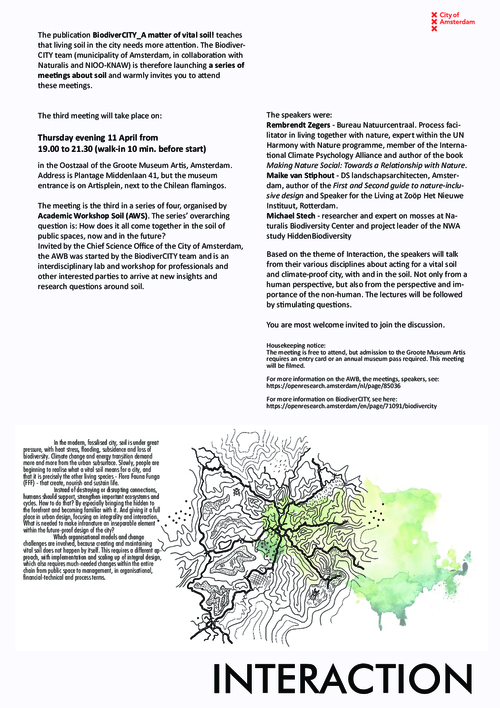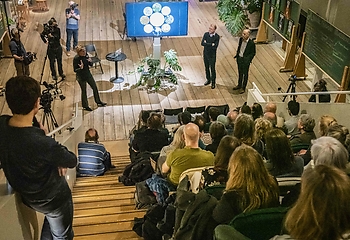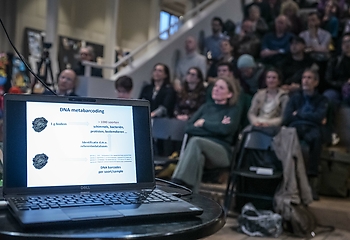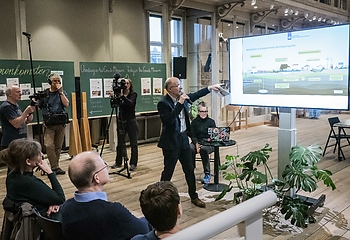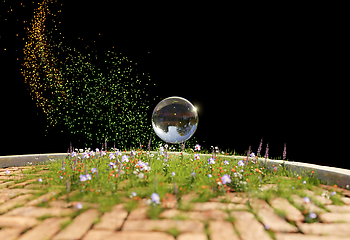The third meeting in the AWB series took place on Thursday evening 11 April in the Oostzaal of the Groote Museum Artis in Amsterdam. Based on the theme INTERACTION, the three speakers each spoke from their different professional disciplines about soil, about acting for a vital soil and climate-proof city, in and with the soil. They spoke not only from the perspective of the human, but also from the perspective and importance of the non-human.
Rembrandt Zegers of Bureau Natuurcentraal kicked off the evening. He works as a process supervisor in living together with nature, is an expert within the UN Harmony with Nature programme and works as a consultant on commons at Cross Cultural Bridges.
He took visitors on an excursion - how do humans communicate with soil? Through his or her senses. Soil is an actor, small children understand this, they crawl on the ground and move unbiased through sand, mud, litter and green plains and act with what they find, be it plants, animals or bits of rubbish. He bombarded the audience with little brainteasers and tantalising statements such as: 'The only time we are not underground or part of the ground is when we are alive.' And 'While we are alive we are still in exchange with the soil, totally dependent on it.' ‘Do we interact with the soil as if it were dead?’ Or 'Do we interact with the soil as if it were alive?’
Man mainly interacts mechanically with soil, we extract, dig and discharge all kinds of things we humans need, in large numbers, it is an interaction as if the soil is dead. It is mainly the soil intermediaries (implementing organisations) that are allowed to do this.
The advance of intensive agriculture has led to altered soils. Against the human soil intermediaries, he placed the natural soil intermediaries: the soil animals. They give the soil the right attention and nutrition, while humans do not. Man must recognise and acknowledge that nature is an actor and learn to interact with the soil as a living organ. By using holistic principles, regeneration, nature-based solutions and rewilding, based on indigenous cultures. You get fertile soil by, for example, establishing food forests. It functions on its own, without fertilisation, irrigation or dewatering and there is high biodiversity that restores soil fertility. But to get even more done and to get to know actor soil you have to play. But how do you play a game with someone who does not speak human language (nature)? Our senses must be constantly on, walk barefoot, close your eyes and feel your neighbour's presence.
Meaning comes from relationship, according to Maurice Merleau-Ponty, and Zegers emphasises this. Isn't it time for soil playgrounds and observation posts for soil? Which animals live on or in soil, which plants and trees thrive on healthy soil. We must diligently look for other forms of living together, such as cooperatives or 'commons'. There are already energy cooperatives, what about soil cooperatives!?
Rembrandt Zegers is director of Bureau Natuurcentraal and author of the publication Making Nature Social: Towards a Relationship with Nature.
https://nl.linkedin.com/in/rembrandt-zegers-phd-77721012
Maike van Stiphout of DS landscape architects took up the mantle and gave an inspiring look into her landscape design kitchen. As a landscape architect, she has long been working on making nature an inseparable part of spatial design. But it is not going fast enough for her; there are still big steps to be made. Culture and nature need to be brought together, not on the basis of ego (with people at the top) but on the basis of eco (people part of). Creating nature in the city is an act of culture, she argues. And using three concepts decorate, frame and share, she showed a selection of beautiful, successful examples of nature making in urban contexts. Look at the city as a mountain landscape and share the facades with urban nature, she invited enthusiastically! In the residential tower Amsterdam Vertical, she and the design team used a programme of animal requirements to make each façade as suitable as possible. With the right planting in the right place, as well as porosity and other architectural applications, the façade is now shared with urban nature.
Everything in the city is man-made except the wild plants and animals, she points out. They are the ones who do it, vitalising the soil and providing much-needed biodiversity. Give them space so they can do their job permanently. But, she adds, making nature in the city is also 'letting' and introduces the aesthetics of rewilding. Stop fighting against nature for fear of being overgrown. Clean selectively, give plants their names and leave vegetation along the wall.
Maike van Stiphout is co-founder of DS landschapsarchitecten and is author of the Eerste en Tweede gids voor natuurinclusief ontwerp.
https://www.dsla.nl/personeel/maike-van-stiphout/
https://nextcity.nl/
https://www.naibooksellers.nl/eerste-gids-voor-natuurinclusief-ontwerp-maike-van-stiphout.html
https://www.naibooksellers.nl/eerste-gids-voor-natuurinclusief-ontwerp-maike-van-stiphout.html
Last in the line of inspiring speakers was Michael Stech, who works as a researcher and expert on mosses at Naturalis and is project leader NWA research HiddenBiodiversity. In this research project, he and his colleagues investigate the hidden biodiversity in urban soils. Literally by looking below ground level, and not only in open ground and tree pits, but also under closed roadways and paved pavements, with and without trees. He does this by using DNA metabarcoding. It should be mentioned that he gets a DNA barcode per species/sample, but cannot tell whether it is DNA from living or dead species. Apart from that, it turns out that there are lots of species under closed road surfaces, many of which we don't know about and can speak of hidden urban nature. Through the study, he knows more, but also less, as the research raises new questions: what do we (not) know about soil biodiversity in the city? What species are there, what role do they play in food webs, what are the developments over time and what connections can be made regarding tree health, urban design and climate, stressors?
For example, Archaea are frequently found precisely in places where there are no trees. Are they indicators of extreme conditions? And fungi, at all the sites investigated (tree pit, pavement with or without trees, road with or without trees) a large proportion is unknown, rising to as much as 40%. First tentative conclusions are: a varied environment with trees, open soil and organic matter increases soil biodiversity, ecological functions and thus (probably) the resilience of the (urban) soil from which measures follow such as: do not let healthy trees give way to infrastructure, reserve a lot of space for greenery, limit organic matter runoff and realise minimum soil cover. Soil tips that can also be found in the booklet Tips for a healthy soil, compiled by Naturalis Biodiversity Center, City Deal Openbare Ruimte, Onder het maaiveld and the municipalities of Amsterdam and Rotterdam.
Michael Stech is a researcher and expert on mosses at Naturalis Biodiversity Center and project leader of the NWA study HiddenBiodiversity
https://natuurwijzer.naturalis.nl/onderzoekers/michael-stech https://www.universiteitleiden.nl/medewerkers/michael-stech
